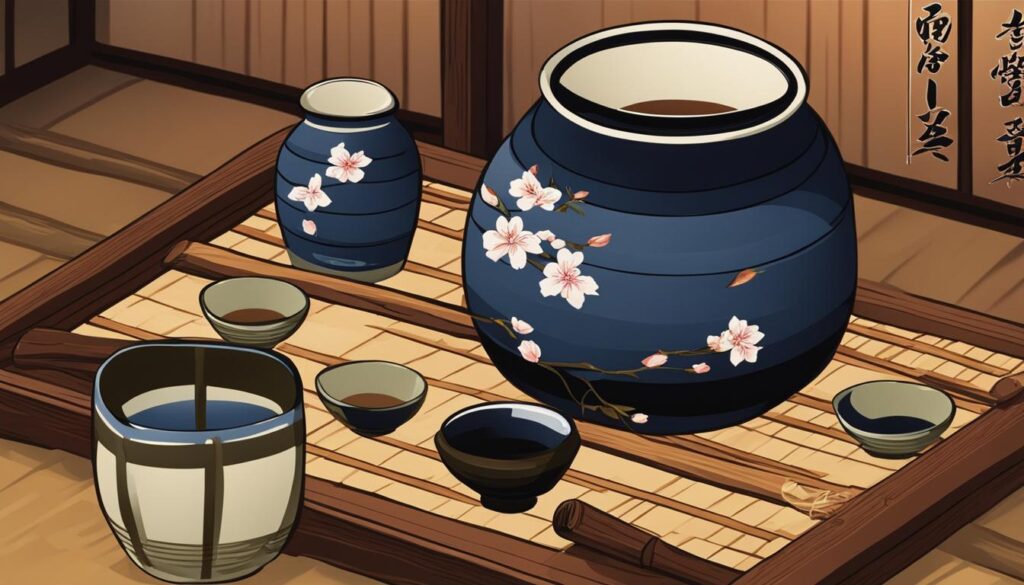Sake, made of rice, is more than just a popular drink in Japanese culture. It holds a significant place in Japanese tradition and plays a role in various aspects of Japanese society. Sake is considered a celestial offering to gods and is used in rituals and ceremonies. It also acts as a bridge between people, connecting individuals and removing social differences. Additionally, sake is an important part of celebrations and is associated with seasonal appreciation. Sake has deep roots in Japanese mythology, appearing in various stories and legends. Understanding the meaning of sake in Japanese culture provides insight into the rich significance of this beloved rice wine.
When exploring the meaning and grammar of “sake” in Japanese, it is essential to understand its kanji representation. The word “sake” is written as 酒 in kanji, which directly translates to “alcohol” or “liquor.” In Japanese, “sake” can refer to any type of alcohol, but it is predominantly used to describe the traditional Japanese rice wine.
Phonetically, “sake” is pronounced as “sah-keh” in Japanese, with the emphasis on the first syllable. The “ah” sound is similar to the “a” in “father,” while the “eh” sound is similar to the “e” in “bet.” It is important to note that unlike the English pronunciation, there is no “y” sound at the end of “sake” in Japanese.
Equivalent words for “sake” in English include “rice wine” or “Japanese rice wine.” These terms are commonly used to describe the beverage and are understood internationally.
In Japanese cultural contexts, the word “sake” carries a deeper meaning than just a beverage. It symbolizes tradition, respect, and connection. Sake is often offered to the gods and ancestors as a sign of reverence and gratitude. It is also associated with celebrations, such as weddings and festivals, where it is served to bring people together and foster a sense of unity.
The Cultural Significance of Sake in Japan
Japanese sake culture is deeply woven into the fabric of Japanese society, influencing religious practices, festivals, rituals, and celebrations. In Japanese religion, particularly in Shintoism, sake plays an important role as an offering to the gods. It is seen as a means of communication and appeasement to the divine. Many shrines across Japan specialize in worshipping sake-related deities, highlighting the significant place sake holds in Japanese religious beliefs.
Sake also takes center stage in various traditional Japanese festivals and rituals. It symbolizes purification and renewal, and its presence is believed to bring good fortune and ward off evil spirits. From the lively festivities of the cherry blossom festivals to the solemn rituals of New Year’s celebrations, sake is a constant companion, enhancing the significance of these cultural events.
Furthermore, sake is an integral part of Japanese celebrations such as weddings and house-building ceremonies. It is often shared among family and friends to mark these joyful occasions, fostering connections and creating memorable experiences. The act of raising a cup of sake together signifies unity and mutual celebration.
Through its presence in Japanese religion, festivals, rituals, and celebrations, sake reflects the deep-rooted cultural significance it holds in Japan. It is not just a drink but a symbol of tradition, heritage, and communal spirit. Embracing sake in these cultural contexts allows for a deeper understanding and appreciation of Japanese culture and the role sake plays in connecting people and enriching their lives.
The Types and Customs of Sake Consumption

When it comes to consuming sake, there are various customs and traditions to be aware of. Understanding these distinctions and customs adds to the overall sake-drinking experience.
Traditional Sake Set
A traditional sake set consists of a tokkuri, a serving carafe, and ochoko, small cups.
Sake Serving Temperature
Sake can be served chilled, warmed, or at room temperature, depending on the type of sake and personal preference.
Types of Sake
Sake comes in different classifications based on the degree of rice polishing. Some common types include:
| Classification | Description |
|---|---|
| Junmai Sake | Sake made purely from rice without the addition of alcohol or additives. |
| Ginjo Sake | Sake brewed with highly polished rice, resulting in a delicate and fruity flavor. |
| Honjozo Sake | Sake made with added alcohol to enhance the aroma and flavor. |
Other Variations
There are also other variations of sake worth mentioning:
- Namazake: Unpasteurized sake with a fresh and vibrant taste.
- Nigorizake: Cloudy sake with a richer and sweeter flavor profile.
- Shiboritate Sake: Freshly pressed sake that captures the lively essence of the brewing process.
Whether you prefer a traditional sake set, enjoy it warm or chilled, or have a particular preference for a specific type of sake, exploring the customs and types of sake consumption enhances the overall enjoyment and appreciation of this beloved Japanese rice wine.
Sake Pairings and Culinary Harmony
Sake is a versatile beverage when it comes to pairing with food. It complements traditional Japanese cuisine, such as sushi, sashimi, and tempura, enhancing the flavors and creating a harmonious dining experience. The delicate and refined nature of sake is a perfect match for the subtle and intricate flavors found in traditional Japanese dishes.
However, sake’s compatibility extends beyond Japanese cuisine. It also pairs well with a variety of non-Japanese cuisines, adding a unique twist to your dining experience. Whether it’s a hearty Italian pasta dish, a flavorful Indian curry, or a spicy Mexican taco, sake has the ability to elevate the flavors and create a delightful balance.
One of the reasons why sake pairs so well with different types of cuisine is its high umami content. Umami, known as the fifth taste, adds depth and richness to dishes. Sake’s umami profile enhances the flavors of rich dishes like stews, ramen, and steak, creating a truly satisfying culinary experience.
Understanding the art of sake and food pairing allows you to explore new flavor combinations and discover the perfect match for each dish. When dining at a restaurant or izakaya, don’t hesitate to ask the staff for sake recommendations that best complement your chosen meal. They are knowledgeable about the different flavor profiles of sake and can suggest the best options based on your preferences.
With sake, you can elevate your dining experience and explore the world of culinary harmony. Whether you’re enjoying traditional Japanese cuisine or savoring international flavors, sake is a beverage that enhances the flavors and creates a memorable gastronomic journey.
Exploring Sake Regions and Brewing Traditions
Sake production is not limited to one region in Japan. Each prefecture has its sake breweries, and some regions are famous for their local sake, known as jizake. One such region is the Nada area of Hyogo, renowned for its bold and sturdy sake. The sake produced here is characterized by its rich aroma and deep flavor profile, making it a favorite among sake enthusiasts. Another notable sake region is Niigata, known for its cleaner and crisper taste. Sake from Niigata is celebrated for its delicate balance and smoothness, often hailed as some of the finest in Japan.
Exploring these sake regions offers an incredible opportunity to delve into the brewing traditions that have shaped the art of sake-making for centuries. From visiting historic breweries to witnessing the meticulous craftsmanship firsthand, you will gain a deeper appreciation for the dedication and skill that goes into producing this beloved rice wine. Many breweries even offer guided tours and sake tastings, allowing you to immerse yourself in the sake-making process and sample a wide range of flavors and styles.
Whether you’re an avid sake connoisseur or just beginning your journey of discovery, embarking on a brewery tour in Japan is an experience that should not be missed. It offers a unique window into the world of sake, where centuries-old traditions meet modern techniques, resulting in an exquisite beverage that embodies the essence of Japanese culture. So, grab your sake cup and embark on a tasting adventure through the enchanting sake regions of Japan.

